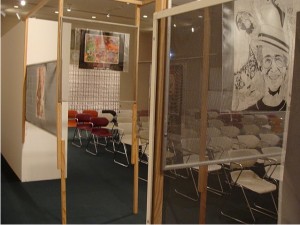
Yes, We Do Have a Cultural Campus
Although the Miami Art Museum is gearing up for the big move, along with the Miami Science Museum, to Museum Park on the bay, it’s easy to forget that MAM already forms a museum park of sorts, in its current downtown campus. (To be frank, some might not even know it exists at all.) Several shows encircling the cultural plaza off of Flagler are a good way to reacquaint yourself with the location.
As reviewed earlier, MAM has a large, all-local exhibit that has just opened at the museum, which will include special, interactive nights throughout the rest of the summer. But you may not know that two of the featured artists in “New Work Miami 2010” are also featured in a quirky show across the plaza in the main Miami-Dade Public Library. Gean Moreno and Ernesto Oroza turned traditional gallery notes for the “New Work” exhibit into a tabloid hand-out, found not just in the gallery “reading room” but also in select spots around town.
Over at the library, they have also produced some interesting written word pieces, this time focusing on the role and place of the junkyard in our society — some of these tabloids are used as wallpaper here. “Driftwood” departs from the usual; while displaying posters and other works, it feels more like an experiential installation, where the point may be to contemplate the space and the ideas behind the theme (junk, or the world of the discarded) more than on specific pieces in a show. You can chew on, for instance, the idea that “Discoveries of objects discarded in mass quantities, like analog televisions, pink toilets, and neon ceramic tile, reveal changes in the culture, values, functions and aesthetics of a place.”
Next door, at HistoryMiami (formerly the Historical Museum of Southern Florida), another new exhibit timed to our hurricane season: “Natural Disasters of the Caribbean: 1495-2010.” As we all were so painfully reminded only this year, an earthquake like the one that struck Haiti can change the entire course of events in the Caribbean, of which we really are a part, sitting up on the northern tip. Although storms, floods, and earth tremors have impacted human life in the region for thousands of years, maybe the first recorded incident occurred in 1500, when Christopher Columbus, fresh off his “discovery,” experienced his first hurricane.
Printed materials, photographs, and images illustrate this history, including a 1690 earthquake in Jamaica; a 1904 volcanic eruption in Martinique; and the devastating pan-Caribbean hurricanes of 1926.
If you desire more knowledge, remember the library is one building away. If you want to see how contemporary artists deal with our environment today, step the other way and enter MAM.
With very little effort and money, culture is all there on the plaza.
“Driftwood” through Sept. 7, at the Main Library, 101 W. Flagler St., Miami; free; 305-375-2665; www.mdpls.org. “Natural Disasters of the Caribbean, 1495-2010” through Aug. 29 at HistoryMiami, 101 West Flagler St., Miami: 305-375-1493; www.hmsf.org.
“New Work Miami 2010,” through Oct. 17 at Miami Art Museum, 101 W. Flagler St., Miami; 305-375-3000; www.miamiartmuseum.org/
Recent Content
-
Artsarticle ·
-
Artsarticle ·
-
Artsarticle ·


